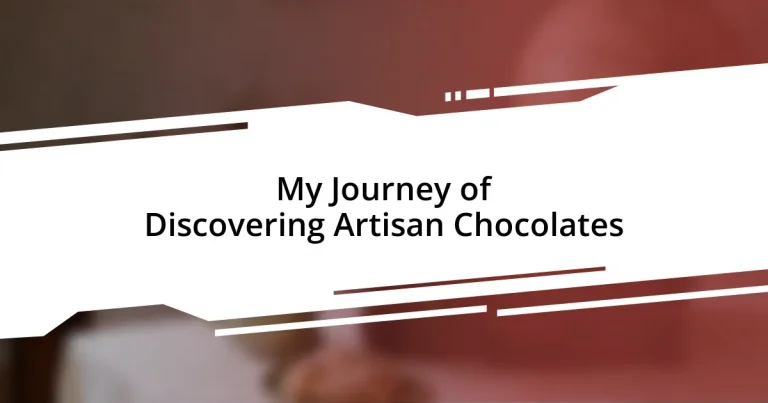Key takeaways:
- The author’s passion for artisan chocolates began at a local festival, leading to a deeper exploration of their craftsmanship and history.
- Chocolate has a rich history dating back to ancient Mesoamerican cultures, evolving from a bitter drink to a beloved sweet treat in Europe and beyond.
- Different types of chocolate, such as dark, milk, white, and single-origin, each have unique flavor profiles influenced by their origin and production methods.
- Pairing artisan chocolates with beverages, like red wine or matcha tea, enhances the tasting experience and evokes vivid emotions and memories.
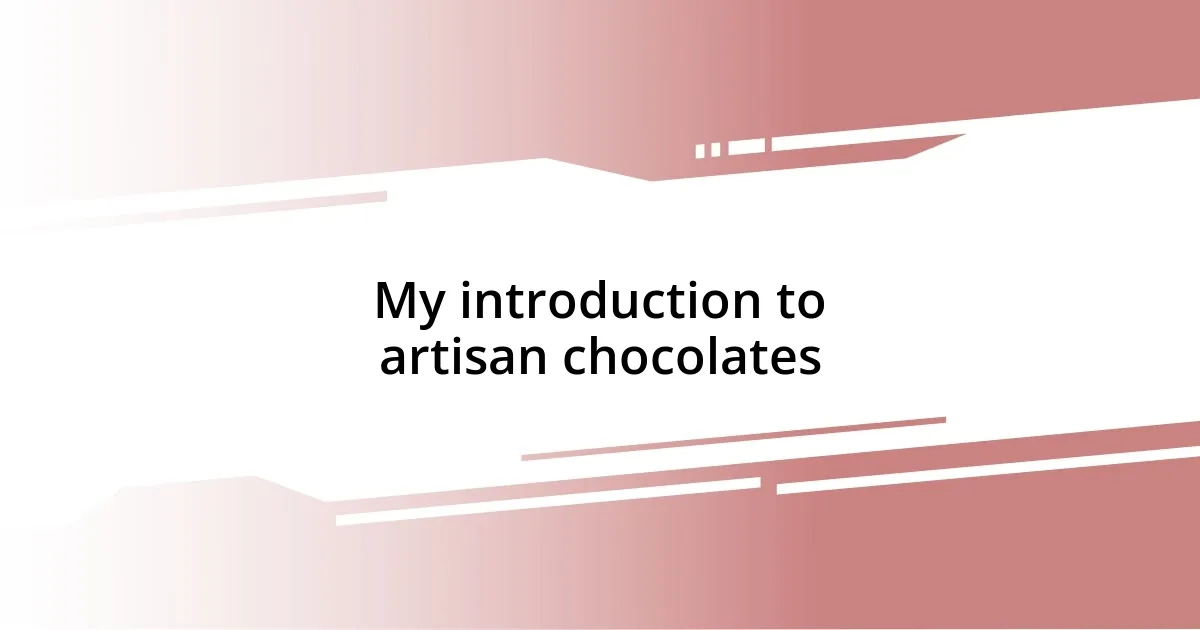
My introduction to artisan chocolates
I still remember the first time I stumbled upon artisan chocolates at a local festival. The vibrant displays and rich aromas pulled me in, each chocolate piece resembling a small work of art. I often wonder, can something so simple as chocolate evoke such joy and excitement?
As I took my first bite of a handcrafted dark chocolate truffle, it was as if a whole new world opened up. The flavors were complex, dancing on my palate and igniting a curious spark within me. Have you ever tasted something that completely changes your perspective on a familiar treat?
From that moment, I became a passionate explorer of artisan chocolates, eager to learn about the craftsmanship behind each creation. I found joy not just in tasting but in discovering the stories and techniques that artisans pour into their work. It’s fascinating to think about how much love and dedication goes into every single piece, isn’t it?
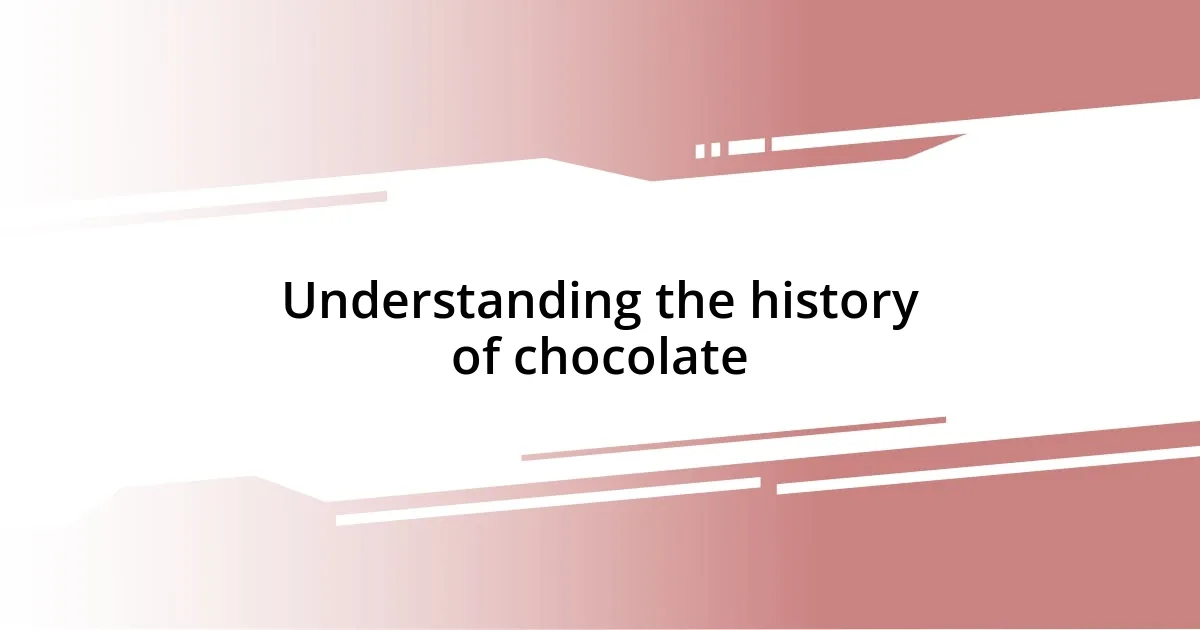
Understanding the history of chocolate
Chocolate’s rich history is as captivating as its flavor. Did you know that chocolate has been enjoyed for thousands of years? The journey starts with the ancient Mesoamerican cultures, like the Olmecs and Mayans, who believed cacao was a gift from the gods. I once visited a small museum showcasing artifacts from these civilizations, and it struck me how deeply cocoa was woven into their rituals and daily lives.
Here are some key points that highlight chocolate’s fascinating evolution:
- Cacao Cultivation: The Olmecs are thought to be the first to cultivate cacao around 1500 BC.
- Mythology and Rituals: The Mayans used cacao in religious ceremonies, often as a drink prepared with spices and consumed during sacred rituals.
- European Introduction: Chocolate reached Europe in the 16th century, transforming from a bitter beverage into a sweetened delight with sugar and milk.
- Industrial Revolution: The 19th century brought significant advancements, leading to the mass production of chocolate and its various forms today, such as bars and candies.
Whenever I indulge in artisan chocolates, I can’t help but feel a connection to this extensive timeline, a blend of ancient traditions melding with contemporary craftsmanship. Each bite seems to echo the stories of those who came before me.
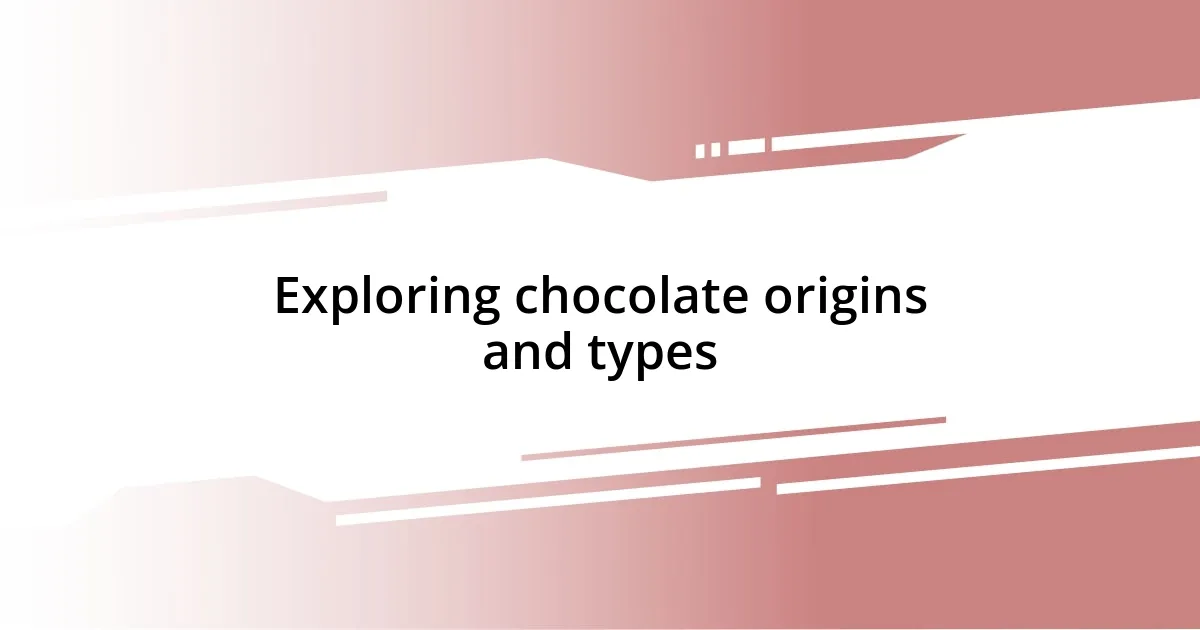
Exploring chocolate origins and types
Exploring the origins of chocolate takes us on a delicious journey through diverse landscapes and cultures. For instance, each chocolate type can be traced back to its unique origin, with regions like Ecuador, Madagascar, and Ghana known for producing distinct flavor profiles. I once sampled a single-origin dark chocolate from Madagascar, and the bright berry notes surprised me. Have you ever tasted chocolate that reminded you of a childhood memory? That chocolate did, and the experience deepened my appreciation for how geography and climate influence flavor.
As I delved deeper, I discovered various types of chocolate, each with its specific characteristics. Dark chocolate, known for its higher cocoa content, offers rich, intense flavors, while milk chocolate provides a creamier, sweeter experience. I vividly remember trying a white chocolate infused with lavender—it was an unexpected twist that awakened all my senses. Exploring these types taught me that chocolate can be both familiar and full of surprises.
Now, let’s take a closer look at the chocolate types and their origins:
| Chocolate Type | Origin Characteristics |
|---|---|
| Dark Chocolate | High cocoa content, rich in antioxidants, often has fruity or nutty notes. |
| Milk Chocolate | Sweeter and creamier, balances cocoa with milk, and often inspired by childhood treats. |
| White Chocolate | Made from cocoa butter, lacks cocoa solids which results in a sweeter flavor, often enhanced with spices or flavors. |
| Single-Origin Chocolate | Chocolate from a specific region, often reflecting the unique terroir, showcasing flavors distinct to its location. |
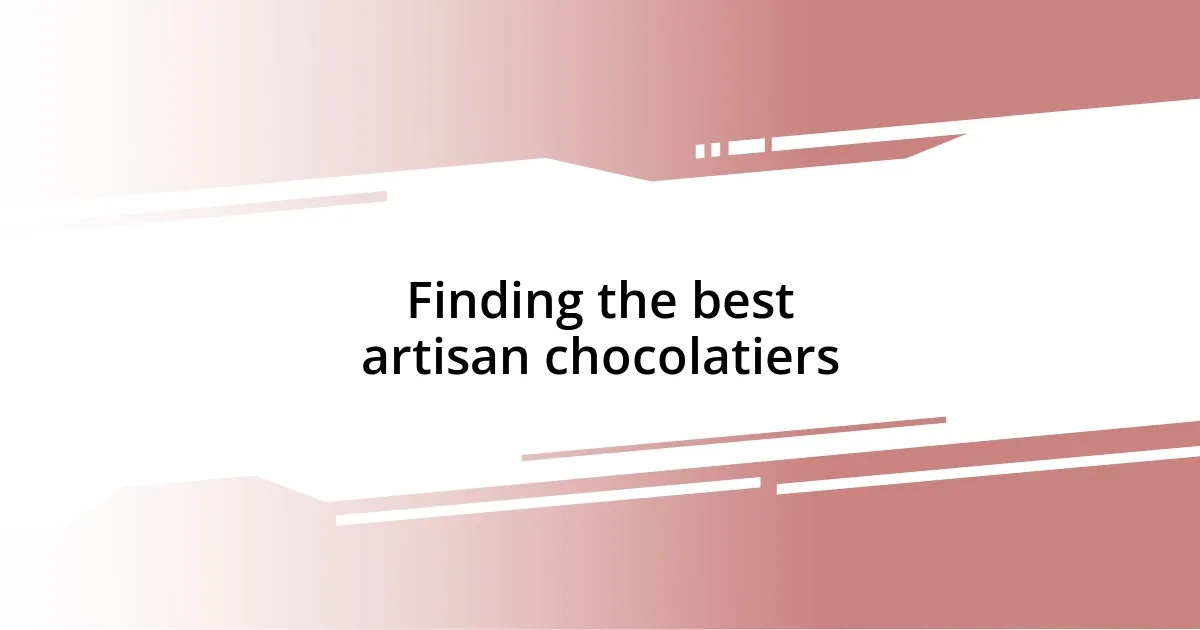
Finding the best artisan chocolatiers
Finding the best artisan chocolatiers can feel like a delightful adventure. One evening, while strolling through a quaint farmers’ market, I stumbled upon a local chocolatier whose small booth was brimming with handcrafted delights. The moment I took a bite of their signature sea salt caramel chocolate, I knew I was onto something special. Have you ever experienced a flavor that instantly felt like a memory waiting to be relived? That’s what artisan chocolates do—they evoke emotions and memories.
To truly discover the finest artisanal chocolatiers, I recommend visiting specialty shops and local markets where artisans often showcase their work. I remember chatting with a chocolatier who passionately shared the story behind each flavor and ingredient. Their enthusiasm not only enhanced the tasting experience but also revealed the craftsmanship that defined their chocolates. It’s this personal connection that elevates artisan chocolate from mere confectionery to a heartfelt journey.
Social media and online communities can be excellent resources, too. They often reveal hidden gems and recommendations from fellow chocolate enthusiasts. I’ve found delightful chocolatiers through Instagram, where their creative presentations and flavors sparked my curiosity. Engaging in these conversations made me feel part of a larger community, united by a shared passion for artisanal chocolate. It invites a question: how does chocolate bring us together in ways we hadn’t realized before? Each artisan chocolatier I discovered offered not just chocolate, but a narrative waiting to be tasted.

Tasting techniques for chocolate connoisseurs
When tasting chocolate, I’ve found that starting with a slow, intentional approach enhances the flavors dramatically. Begin by observing the chocolate’s appearance; notice its sheen and snap as you break a piece apart. I remember first experiencing this at a chocolate tasting event where we were encouraged to appreciate the artistry before diving in. Can you believe how just a simple crack can heighten your anticipation?
Next comes the all-important aroma. I’ve learned to bring the chocolate close to my nose, inhaling deeply to uncover the hidden scents. One time, sniffing a bar of dark chocolate, I detected notes reminiscent of freshly brewed coffee, which completely shifted my perception of what I thought chocolate could offer. Isn’t it fascinating how scent can transport us to different moments and places? The olfactory experience is crucial—it prepares our palate for the flavor journey ahead.
Finally, the tasting itself should be a mindful experience. Allow the chocolate to melt on your tongue, observing the texture and how the flavors evolve. I’ll never forget savoring a piece infused with chili; the initial sweetness gradually gave way to a gentle heat that lingered. It’s moments like this that make me appreciate chocolate not just as a treat, but as an intricate collection of sensations. Have you ever let a chocolate linger long enough for its layers to unfold? It’s an experience that can truly shift your understanding of this beloved indulgence.
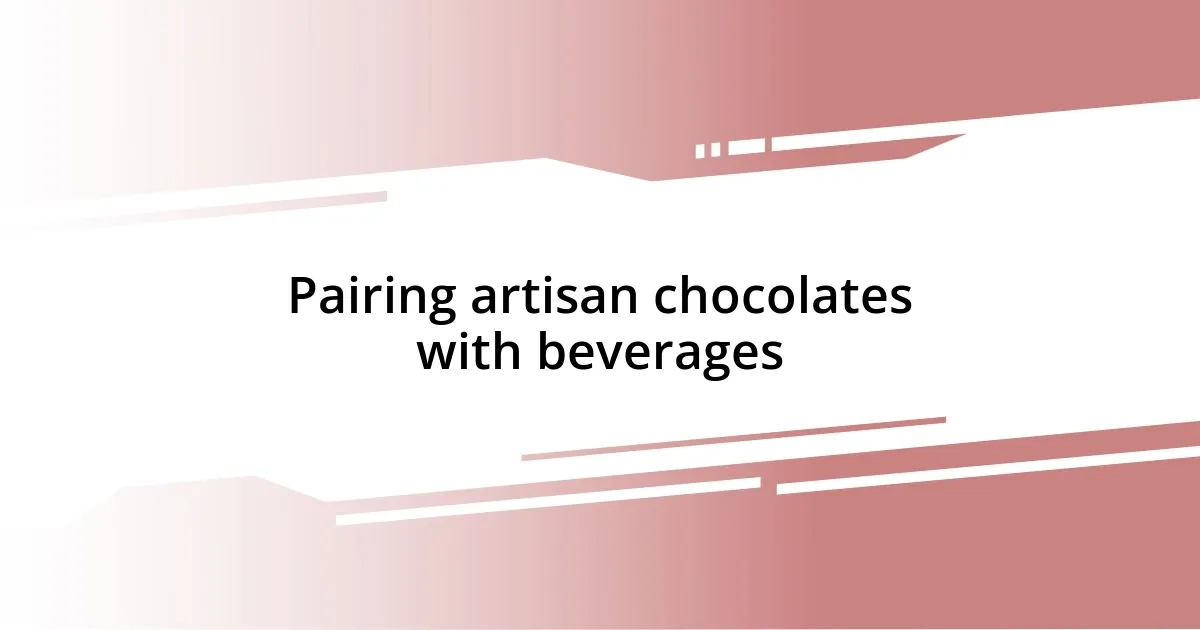
Pairing artisan chocolates with beverages
Pairing artisan chocolates with beverages can elevate the tasting experience to new heights. For instance, I’ll never forget the first time I enjoyed a bold, dark chocolate with a rich red wine. The deep fruitiness of the wine harmonized beautifully with the chocolate’s complex flavors, creating a dance of taste on my palate. Have you ever experienced a pairing that transformed the way you appreciate both the drink and the dessert? It’s moments like those that make you realize how thoughtfully chosen combinations can ignite a passionate appreciation for flavors.
When it comes to lighter chocolates, I discovered a delightful balance with matcha tea. The earthiness of the matcha paired with a creamy white chocolate created a refreshing encounter that lingered long after the last bite. I remember sitting on my patio, a sunny afternoon breeze caressing my skin, and feeling a rush of pure bliss with each taste. Isn’t it interesting how certain flavors can evoke such vivid emotions and memories, almost like an olfactory time capsule?
Coffee is another classic pairing that never disappoints. One morning, I indulged in an espresso alongside a handmade toffee chocolate, and the experience was transformative. The bitterness of the coffee contrasted sharply with the sweetness of the chocolate, resulting in an astonishingly rich flavor profile that kept me coming back for more. Have you ever paired chocolate with your favorite beverage and felt the magic of that perfect union? I can assure you, these seemingly simple combinations can spark a whole new journey of flavor exploration.












